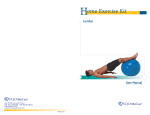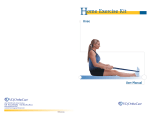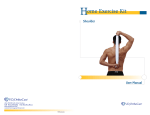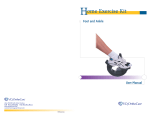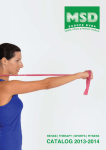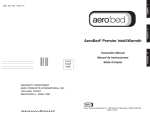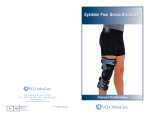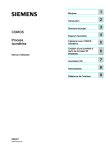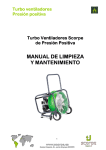Download VQO15032602_cervical manual.qxd
Transcript
Home Exercise Kit Cervical User Manual 18011 Mitchell South, Irvine, CA 92614 Call 800.266.6969 Fax 800.821.8012 www.vqorthocare.com [email protected] VQO15032602 VQ OrthoCare Exercise Kit Cervical Kit Items included in your kit: • Exercise Ball (see inflation instructions on back page) • Backnobber®II • Air Pump • Exercise Band Kit • 2 Handles • Blue, Green, Red Rubber Bands • Strap with Loop • Pouch • Towel VQ OrthoCare is not liable for any misuse or misunderstanding of the exercise product or operating manual. Please call your local representative if any additional assistance is required regarding this product and its operating instructions. Caution: Consult with your therapist or physician before starting any rehabilitation or exercise program. The products in this exercise kit are not to be used by children without adult supervision. Caution: This product contains natural rubber latex which may cause allergic reactions. As with all natural rubber products, keep this product away from grease, oil or excessive heat. Disclaimer: Equipment and supplies illustrated and specified are subject to modification consistent with product availability or other factors. VQ OrthoCare 18011 Mitchell South, Irvine, CA 92614-6007 800.266.6969 • Fax 800.821.8012 www.vqorthocare.com • [email protected] The publishers acknowledge that the illustrations used in this publication on pages 2,3,4,5,6, 7,8,9,10,11,12,13,14,15,16 are the copyrighted property of VHI Inc. Backnobber is a registered trademark of The Pressure Positive Company. This operating manual is proprietary and confidential. No part of this document may be reproduced or transmitted in any form or by any means, electronic or mechanical, including photocopy, recording or information storage and retrieval system, without permission in writing from VQ OrthoCare. VQ OrthoCare is a service mark of VisionQuest Industries, Inc. © 2005 Quick Reference Exercise Listing Cervical Neck Flexion . . . . . . . . . . . . . . . . . . . . . . . . . . . . . . . . . . . . . . . . . . . . .2 Neck Extension . . . . . . . . . . . . . . . . . . . . . . . . . . . . . . . . . . . . . . . . . . .3 Neck Rotation . . . . . . . . . . . . . . . . . . . . . . . . . . . . . . . . . . . . . . . . . . . .4 Neck Sidebending . . . . . . . . . . . . . . . . . . . . . . . . . . . . . . . . . . . . . . . . .5 Shoulder Shrugs . . . . . . . . . . . . . . . . . . . . . . . . . . . . . . . . . . . . . . . . . .6 Cervical Isometrics Flexion and Extension . . . . . . . . . . . . . . . . . . . . . . . . . . . . . . . . . . .7 Sidebending and Rotation . . . . . . . . . . . . . . . . . . . . . . . . . . . . . . . .8 Exercise Ball – Neck Rotation . . . . . . . . . . . . . . . . . . . . . . . . . . . . . . . . .9 Trunk Rotation . . . . . . . . . . . . . . . . . . . . . . . . . . . . . . . . . . . . . . . . . . .10 Exercise Ball – Shoulder External Rotation . . . . . . . . . . . . . . . . . . . . .11 Exercise Ball – Arm Curls . . . . . . . . . . . . . . . . . . . . . . . . . . . . . . . . . . .12 Exercise Ball External Diagonal Pulls (High to Low) . . . . . . . . . . . . . .13 Exercise Ball Internal Diagonal Pulls (High to Low) . . . . . . . . . . . . . .14 Exercise Ball Internal Diagonal Pull (Low to High) . . . . . . . . . . . . . . .15 Exercise Ball External Diagonal Pull (Low to High) . . . . . . . . . . . . . . .16 NECK FLEXION This exercise can be done either sitting or standing. Begin with your head up, shoulders slightly back, and eyes facing forward. Position your head so that your ear lobes are directly over the center of your shoulders. Keep your shoulders slightly back as if you are slightly pinching them together and keep your feet apart as wide as your hips. Slowly bend your head and neck downward toward the floor as if you are looking at your feet. Flex your neck only as far as you can go comfortably. Hold for 3 seconds then bend your neck back to the starting position. Repeat 5 times and do 3 sessions daily. 2 NECK EXTENSION This exercise can be done either sitting or standing. Begin with your head up, shoulders slightly back, and eyes facing forward. Position your head so that your ear lobes are directly over the center of your shoulders. Keep your shoulders slightly back as if you are slightly pinching them together and keep your feet apart as wide as your hips. Slowly bend your head and neck backward until you are looking at the ceiling. Extend your neck back only as far as you can go comfortably. Hold for 3 seconds then bend your neck back to the starting position. Repeat 5 times and do 3 sessions daily. 3 NECK ROTATION This exercise can be done either sitting or standing. Begin with your head up, shoulders slightly back, and eyes facing forward. Position your head so that your ear lobes are directly over the center of your shoulders. Keep your shoulders slightly back as if you are slightly pinching them together and keep your feet apart as wide as your hips. Turn your head slowly and look over one shoulder, then the other. Rotate only as far as you can go comfortably. Hold for 3 seconds on each side then return to the starting position. Repeat 5 times and do 3 sessions daily. 4 NECK SIDEBENDING This exercise can be done either sitting or standing. Begin with your head up, shoulders slightly back, and eyes facing forward. Position your head so that your ear lobes are directly over the center of your shoulders. Keep your shoulders slightly back as if you are slightly pinching them together and keep your feet apart as wide as your hips. Bend your neck to one side so that you are bringing your ear toward your shoulder. Bend your neck only, do not shrug your shoulder. Side bend your neck only as far as you can go comfortably. Hold for 3 seconds then return to starting position. Repeat 5 times and do 3 sessions daily. 5 SHOULDER SHRUGS This exercise can be done either sitting or standing. Begin with your head up, shoulders slightly back, and eyes facing forward. Position your head so that your ear lobes are directly over the center of your shoulders. Keep your shoulders slightly back as if you are slightly pinching them together and keep your feet apart as wide as your hips. Shrug shoulders up toward the ceiling and backwards trying to pinch your shoulder blades together. Hold for 3 seconds. Relax, then repeat 10 - 15 times. Do 3 sessions daily. 6 FLEXION (Cervical Isometrics) EXTENSION (Cervical Isometrics) CERVICAL ISOMETRICS Begin either sitting or standing with your head up, shoulders slightly back, and eyes facing forward. Position your head so that your ear lobes are directly over the center of your shoulders. Keep your shoulders slightly back as if you are slightly pinching them together and keep your feet apart as wide as your hips. Cervical Isometrics– Flexion: Using the fingertips of your hand, apply light pressure to your forehead and resist bending your head forward. Hold for 3 seconds. Relax then repeat 10-15 times. Do 3 sessions daily. Cervical Isometrics– Extension: Using the fingertips of your hand apply light pressure to the back of your head and resist bending your head backward. Hold for 3 seconds. Relax then repeat 10-15 times. Do 3 sessions daily. 7 SIDEBENDING (Cervical Isometrics) ROTATION (Cervical Isometrics) CERVICAL ISOMETRICS Begin either sitting or standing with your head up, shoulders slightly back, and eyes facing forward. Position your head so that your ear lobes are directly over the center of your shoulders. Keep your shoulders slightly back as if you are slightly pinching them together and keep your feet apart as wide as your hips. Cervical Isometrics– Sidebending: Using your left hand apply light pressure to the left side of your head and resist bending your head to that side. Hold for 3 seconds. Relax. Using your right hand apply light pressure to the right side of your head and resist bending your head to that side. Hold for 3 seconds. Relax. Alternate sides and repeat 10-15 times. Do 3 sessions daily. Cervical Isometrics– Rotation: Using the fingertips of your right hand apply light pressure to the side of your forehead and resist rotating your head toward the right side. Hold for 3 seconds. Relax. Using your left hand, resist rotating your head toward the left side. Hold for 3 seconds. Relax. Alternate sides repeat 10-15 times. Do 3 sessions daily. 8 EXERCISE BALL– NECK ROTATION Sit on the ball with your head up, shoulders slightly back, and eyes facing forward. Position your head so that your ear lobes are directly over the center of your shoulders. Keep your shoulders slightly back as if you are slightly pinching them together and keep your feet apart as wide as your hips. Slowly rotate your head to one side then the other. Remember to keep your eyes level and maintain good posture. Repeat rotation 10-15 times to each side. Do 3 sessions daily. 9 TRUNK ROTATION Sit on a chair or ball with your head up, shoulders slightly back, and eyes facing forward. Position your head so that your ear lobes are directly over the center of your shoulders. Slightly pinch your shoulder blades together. Arms can be crossed over your chest or out to your sides. Slowly rotate your trunk to each side while keeping your head and neck facing forward. It may be helpful, once you are in the starting position, to visually pick a spot on the wall in front of you and rotate trunk while keeping your head and neck straight and stare at the spot on the wall so you do not move your head at all. Do not force the rotation so far that your neck or head rotates with your trunk. Slowly return to the starting position. Repeat 10-15 times. Do 3 sessions daily. 10 EXERCISE BALL– SHOULDER EXTERNAL ROTATION Place the exercise band handle between the door and the doorframe about 3 feet from the floor and closing the door to secure the band. Sit on the ball with your head up and eyes facing forward. Have your ears lined up over your shoulders. Keep your shoulders back as if you are slightly pinching them together and keep your feet apart as wide as your hips. Sit with one side facing the door. On the side farthest away from the door, place a folded towel under the arm and squeeze it gently between the arm and body. Grip the exercise band handle in the hand of the arm holding the towel. Hold your hand and forearm at a 90 degree angle parallel to the floor. Slowly rotate your hand and forearm out to the side as far as possible away from your body, putting tension on the exercise band. Return to the starting position. Repeat 10-15 times then alternate and do the opposite arm. Do 3 sessions daily. 11 EXERCISE BALL– ARM CURLS Slide the exercise band through the “D” ring of the exercise band strap. Attach both handles. Place the exercise band strap between the door and doorframe about 2 inches from the floor. Secure the band by slipping it between the door and the frame and closing the door. Sit on the ball with your head up and eyes facing forward. Have your ears lined up over your shoulders. Keep your shoulders back as if you are slightly pinching them together and keep your feet apart as wide as your hips. Sit facing the door. Grab both handles of the exercise band with your palms facing up. Keep your elbows at your side and do an arm curl by flexing the muscles in your forearm and upper arm. Repeat 10-15 times on both sides. Do 3 sessions daily. You may also alternate this exercise and grip the tubing with your palms facing down. 12 EXERCISE BALL– EXTERNAL DIAGONAL PULL (HIGH TO LOW) Place one exercise band handle between the door and the doorframe about 2 inches from the top of the door. Secure the handle by slipping it between the door and the frame and closing the door. Sit on the ball with your head up and eyes facing forward. Have your ears lined up over your shoulders. Keep your shoulders back as if you are slightly pinching them together and keep your feet apart as wide as your hips. Sit with one side facing the door. Grab the other handle with the hand farthest away from the door. While keeping your arm straight pull the exercise band across your body toward the floor. Keep your palm facing toward you. Return slowly to the starting position. Repeat 10-15 times. Switch sides and do other arm. Do 3 sessions daily. 13 EXERCISE BALL– INTERNAL DIAGONAL PULL (HIGH TO LOW) Place the exercise band handle between the door and the doorframe about 2 inches from the top of the door. Secure the handle by slipping it between the door and the frame and closing the door. Sit on the ball with your head up and eyes facing forward. Have your ears lined up over your shoulders. Keep your shoulders back as if you are slightly pinching them together and keep your feet apart as wide as your hips. Sit with one side facing the door. Grab the other handle with the hand closest to the door. While keeping your arm straight pull the exercise band downward across your body. Your thumb will be up at the beginning of the exercise and, as you pull downward across your body, the thumb will end up in the down position. Return slowly to the starting position. Repeat 10-15 times. Switch sides and do other arm. Do 3 sessions daily. 14 EXERCISE BALL– INTERNAL DIAGONAL PULL (LOW TO HIGH) Place the exercise band handle between the door and the doorframe about 2 inches from the floor. Secure the handle by slipping it between the door and the frame and closing the door. Sit on the ball with your head up and eyes facing forward. Have your ears lined up over your shoulders. Keep your shoulders back as if you are slightly pinching them together and keep your feet apart as wide as your hips. Sit with one side facing the door. Grab the exercise band with the hand farthest from the door. While keeping your arm straight pull the exercise band up and across your body. Keep thumb pointing upward during the exercise. Return slowly to starting position. Repeat 10-15 times. Switch sides and do other arm. Do 3 sessions daily. 15 EXERCISE BALL EXTERNAL DIAGONAL PULL (LOW TO HIGH) Place the exercise band handle between the door and the doorframe about 2 inches from the floor. Secure the handle by slipping it between the door and the frame and closing the door. Sit on the ball with your head up and eyes facing forward. Have your ears lined up over your shoulders. Keep your shoulders back as if you are slightly pinching them together and keep your feet apart as wide as your hips. Sit with one side facing the door. Grab the exercise band with the hand closest to the door. While keeping your arm straight pull the exercise band up and across your body. Keep thumb pointing upward during the exercise. Return slowly to starting position. Repeat 10-15 times. Switch sides and do other arm. Do 3 sessions daily. 16 Please refer to the Backnobber®II Exercise book for specific exercises and instruction. Instructions for inflating exercise ball Step 1: Attach short white fill tube to end of air pump. Step 2: Insert tip of white fill tube directly into the exercise ball. Step 3: Using the air pump, inflate the exercise ball until the desired level of firmness is attained. Note: The exercise balls may be “under” inflated to give a soft feel or “over” inflated for a firm feel. Step 4: When inflation is complete, quickly remove the air pump from the exercise ball and insert the long white plug, pushing until flush with the ball surface. Figure 4a: Long white plug Figure 4b: Completed inflated exercise ball with plug flush with ball surface. Optional Inflation Method If desired, an alternative air pump such as a bicycle pump or compressor pump can be used to inflate the exercise ball. NOTES VQ OrthoCare kit de ejercicios Kit de ejercicios cervicales Artículos contenidos en el kit: • Pelota de ejercicios (en la contraportada encontrará las instrucciones de inflado) • Aparato para masaje Backnobber®II • Bomba de aire • Kit de bandas elásticas para ejercicio • 2 asas • Bandas elásticas azul, verde y roja • Tira con presilla • Bolsa • Toalla VQ OrthoCare no se hará responsable de ningún uso incorrecto o mala interpretación del producto para ejercicio o manual de instrucciones. Si necesita asistencia adicional respecto a este producto y sus instrucciones de manejo, llame a su representante local. Advertencia: Antes de iniciar cualquier programa de rehabilitación o de ejercicios, consulte con su terapeuta o médico. Los productos de este kit para ejercicios no deben ser usados por niños sin la supervisión de un adulto. Advertencia: Este producto contiene látex de caucho natural, el cual puede ocasionar reacciones alérgicas. Como en el caso de cualquier artículo de caucho natural, mantenga este producto al resguardo de grasa, aceite o altas temperaturas. Descargo de responsabilidad: El equipo y los suministros que se ilustran y especifican están sujetos a modificaciones consecuentes con la disponibilidad del producto u otros factores. VQ OrthoCare 18011 Mitchell South, Irvine, CA 92614-6007 800.266.6969 • Fax 800.821.8012 www.vqorthocare.com • [email protected] Los editores reconocen que las ilustraciones que aparecen en las páginas 2,3,4,5,6,7,8,9,10, 11,12,13,14,15 y 16 de esta publicación son propiedad intelectual de VHI Inc. Backnobber es una marca registrada de The Pressure Positive Company. Este manual de instrucciones está patentado y es confidencial. Ninguna parte de este documento puede ser reproducida ni transmitida de ninguna forma ni por ningún medio, electrónico o mecánico, sea por fotocopia, en sistemas de registro o de almacenamiento y recuperación de información, sin el permiso por escrito de VQ OrthoCare. VQ OrthoCare es una una marca servicio de VisionQuest Industries, Inc. © 2005 Lista de consulta rápida Ejercicios cervicales Flexión del cuello . . . . . . . . . . . . . . . . . . . . . . . . . . . . . . . . . . . . . . . . .2 Extensión del cuello . . . . . . . . . . . . . . . . . . . . . . . . . . . . . . . . . . . . . . .3 Rotación del cuello . . . . . . . . . . . . . . . . . . . . . . . . . . . . . . . . . . . . . . . .4 Flexión lateral del cuello . . . . . . . . . . . . . . . . . . . . . . . . . . . . . . . . . . . .5 Encogimiento de hombros . . . . . . . . . . . . . . . . . . . . . . . . . . . . . . . . . .6 Isométricos cervicales Flexión y extensión . . . . . . . . . . . . . . . . . . . . . . . . . . . . . . . . . . . . .7 Flexión lateral y rotación . . . . . . . . . . . . . . . . . . . . . . . . . . . . . . . .8 Rotación del cuello sobre pelota de ejercicios . . . . . . . . . . . . . . . . . .9 Rotación del tronco . . . . . . . . . . . . . . . . . . . . . . . . . . . . . . . . . . . . . . .10 Rotación externa de los hombros sobre pelota de ejercicios . . . . .11 Flexión de brazos sobre pelota de ejercicios . . . . . . . . . . . . . . . . . . .12 Tirones diagonales externos sobre pelota de ejercicios (de arriba a abajo) . . . . . . . . . . . . . . . . . . . . . . . . . . . . . . . . . . . . . . . .13 Tirones diagonales internos sobre pelota de ejercicios (de arriba a abajo) . . . . . . . . . . . . . . . . . . . . . . . . . . . . . . . . . . . . . . . .14 Tirones diagonales internos sobre pelota de ejercicios (de abajo a arriba) . . . . . . . . . . . . . . . . . . . . . . . . . . . . . . . . . . . . . . . .15 Tirones diagonales externos sobre pelota de ejercicios (de abajo a arriba) . . . . . . . . . . . . . . . . . . . . . . . . . . . . . . . . . . . . . . . .16 FLEXIÓN DEL CUELLO Este ejercicio se puede hacer ya sea sentado o de pie. Comience con la cabeza erguida, los hombros ligeramente hacia atrás y los ojos mirando hacia adelante. Coloque la cabeza de modo que los lóbulos de las orejas le queden directamente sobre el centro de los hombros. Mantenga los hombros ligeramente hacia atrás como si estuviera tratando de aproximarlos entre sí, y aparte los pies de modo que estén alineados con las caderas. Incline lentamente la cabeza y el cuello hacia abajo en dirección del piso, como si estuviera mirándose los pies. Flexione el cuello sólo hasta donde pueda hacerlo cómodamente. Mantenga esta posición por 3 segundos y suba la cabeza para devolver el cuello a su posición de partida. Repita este ejercicio 5 veces y haga 3 sesiones al día. 2 EXTENSIÓN DEL CUELLO Este ejercicio se puede hacer ya sea sentado o de pie. Comience con la cabeza erguida, los hombros ligeramente hacia atrás y los ojos mirando hacia adelante. Coloque la cabeza de modo que los lóbulos de las orejas le queden directamente sobre el centro de los hombros. Mantenga los hombros ligeramente hacia atrás como si estuviera tratando de aproximarlos entre sí, y aparte los pies de modo que estén alineados con las caderas. Incline lentamente la cabeza y el cuello hacia atrás hasta que esté mirando al techo. Extienda el cuello hacia atrás sólo hasta donde pueda hacerlo cómodamente. Mantenga esta posición por 3 segundos y baje la cabeza para devolver el cuello a su posición de partida. Repita este ejercicio 5 veces y haga 3 sesiones al día. 3 ROTACIÓN DEL CUELLO Este ejercicio se puede hacer ya sea sentado o de pie. Comience con la cabeza erguida, los hombros ligeramente hacia atrás y los ojos mirando hacia adelante. Coloque la cabeza de modo que los lóbulos de las orejas le queden directamente sobre el centro de los hombros. Mantenga los hombros ligeramente hacia atrás como si estuviera tratando de aproximarlos entre sí, y aparte los pies de modo que estén alineados con las caderas. Gire la cabeza lentamente y mire por encima de un hombro, luego haga lo mismo con el otro. Gire sólo hasta donde pueda hacerlo cómodamente. Mantenga esta posición por 3 segundos en cada lado y vuelva a la posición de partida. Repita este ejercicio 5 veces y haga 3 sesiones al día. 4 FLEXIÓN LATERAL DEL CUELLO Este ejercicio se puede hacer ya sea sentado o de pie. Comience con la cabeza erguida, los hombros ligeramente hacia atrás y los ojos mirando hacia adelante. Coloque la cabeza de modo que los lóbulos de las orejas le queden directamente sobre el centro de los hombros. Mantenga los hombros ligeramente hacia atrás como si estuviera tratando de aproximarlos entre sí, y aparte los pies de modo que estén alineados con las caderas. Flexione el cuello hacia un lado acercando la oreja hacia el hombro. Doble sólo el cuello; no encoja el hombro. Flexione el cuello lateralmente sólo hasta donde pueda hacerlo cómodamente. Mantenga esta posición por 3 segundos, luego vuelva a la posición de partida. Repita este ejercicio 5 veces y haga 3 sesiones al día. 5 ENCOGIMIENTO DE HOMBROS Este ejercicio se puede hacer ya sea sentado o de pie. Comience con la cabeza erguida, los hombros ligeramente hacia atrás y los ojos mirando hacia adelante. Coloque la cabeza de modo que los lóbulos de las orejas le queden directamente sobre el centro de los hombros. Mantenga los hombros ligeramente hacia atrás como si estuviera tratando de aproximarlos entre sí, y aparte los pies de modo que estén alineados con las caderas. Eleve los hombros hacia el techo y hacia atrás, intentando aproximar los omóplatos entre sí. Mantenga esta posición por 3 segundos. Relájese, luego repita el ejercicio de 10 a 15 veces. Haga 3 sesiones al día. 6 FLEXIÓN (Isométricos cervicales) EXTENSIÓN (Isométricos cervicales) ISOMÉTRICOS CERVICALES Comience ya sea en posición sentada o de pie, con la cabeza erguida, los hombros ligeramente hacia atrás y los ojos mirando hacia adelante. Coloque la cabeza de modo que los lóbulos de las orejas le queden directamente sobre el centro de los hombros. Mantenga los hombros ligeramente hacia atrás como si estuviera tratando de aproximarlos entre sí, y aparte los pies de modo que estén alineados con las caderas. Isométricos cervicales– Flexión: Con las yemas de los dedos, aplique presión ligera a la frente y trate de inclinar el cuello hacia adelante contra resistencia. Mantenga esta posición por 3 segundos. Relájese, luego repita el ejercicio de 10 a 15 veces. Haga 3 sesiones al día. Isométricos cervicales– Extensión: Con las yemas de los dedos, aplique presión ligera a la parte posterior de la cabeza y trate de inclinar el cuello hacia atrás contra resistencia. Mantenga esta posición por 3 segundos. Relájese, luego repita el ejercicio de 10 a 15 veces. Haga 3 sesiones al día. 7 FLEXIÓN LATERAL (Isométricos cervicales) ROTACIÓN (Isométricos cervicales) ISOMÉTRICOS CERVICALES Comience ya sea en posición sentada o de pie, con la cabeza erguida, los hombros ligeramente hacia atrás y los ojos mirando hacia adelante. Coloque la cabeza de modo que los lóbulos de las orejas le queden directamente sobre el centro de los hombros. Mantenga los hombros ligeramente hacia atrás como si estuviera tratando de aproximarlos entre sí, y aparte los pies de modo que estén alineados con las caderas. Isométricos cervicales– Flexión lateral: Con la mano izquierda, aplique presión ligera al lado izquierdo de la cabeza y trate de inclinar el cuello en esa dirección contra resistencia. Mantenga esta posición por 3 segundos y relájese. Con la mano derecha, aplique presión ligera al lado derecho de la cabeza y trate de inclinar el cuello en esa dirección contra resistencia. Mantenga esta posición por 3 segundos y relájese. Cambie de lado y repita el ejercicio 10 ó 15 veces. Haga 3 sesiones al día. Isométricos cervicales– Rotación: Con las yemas de los dedos de la mano derecha, aplique presión ligera a la sien y trate de girar la cabeza hacia la derecha contra resistencia. Mantenga esta posición por 3 segundos y relájese. Con la mano izquierda, gire la cabeza hacia la izquierda contra resistencia. Mantenga esta posición por 3 segundos y relájese. Cambie de lado y repita el ejercicio 10 ó 15 veces. Haga 3 sesiones al día. 8 ROTACIÓN DEL CUELLO SOBRE PELOTA DE EJERCICIOS Siéntese sobre la pelota, con la cabeza erguida, los hombros ligeramente hacia atrás y los ojos mirando hacia adelante. Coloque la cabeza de modo que los lóbulos de las orejas le queden directamente sobre el centro de los hombros. Mantenga los hombros ligeramente hacia atrás como si estuviera tratando de aproximarlos entre sí, y aparte los pies de modo que estén alineados con las caderas. Lentamente, gire la cabeza de un lado a otro. No olvide fijar la vista y conservar una buena postura. Repita la rotación de 10 a 15 veces hacia cada lado. Haga 3 sesiones al día. 9 ROTACIÓN DEL TRONCO Siéntese sobre una silla o pelota, con la cabeza erguida, los hombros ligeramente hacia atrás y los ojos mirando hacia adelante. Coloque la cabeza de modo que los lóbulos de las orejas le queden directamente sobre el centro de los hombros. Trate de aproximar los omóplatos entre sí ligeramente. Puede cruzar los brazos sobre el pecho o ponerlos a los costados. Lentamente, gire el tronco a cada lado mientras mantiene la cabeza y el cuello hacia adelante. Para ayudarle a no mover la cabeza en absoluto, quizás le resulte útil, una vez que esté en la posición de partida, escoger visualmente un punto en la pared frente a usted para fijar la vista en él mientras gira el tronco con la cabeza y el cuello rectos. No fuerce la rotación al punto de que el cuello y la cabeza tengan que girar junto con el tronco. Vuelva lentamente a la posición de partida. Repita este ejercicio de 10 a 15 veces. Haga 3 sesiones al día. 10 ROTACIÓN EXTERNA DE LOS HOMBROS SOBRE PELOTA DE EJERCICIOS Coloque el asa de la banda elástica para ejercicios entre la puerta y su marco, a unos 3 pies (1 metro) del piso; luego cierre la puerta para sujetar la banda. Siéntese sobre la pelota, con la cabeza erguida y los ojos mirando hacia adelante. Deje las orejas alineadas con los hombros. Mantenga los hombros ligeramente hacia atrás como si estuviera tratando de aproximarlos entre sí, y aparte los pies de modo que estén alineados con las caderas. Siéntese con un costado mirando a la puerta. En el costado más alejado de la puerta, póngase una toalla doblada debajo del brazo y apriétela suavemente entre ese brazo y el cuerpo. Agarre el asa libre de la banda elástica con la mano del brazo que sujeta la toalla. Coloque la mano y el antebrazo a un ángulo de 90 grados respecto al brazo, de modo que estén paralelos al piso. Gire lentamente la mano y el antebrazo hacia afuera y a un lado hasta llegar lo más lejos posible del cuerpo, mientras tensa la banda elástica. Vuelva a la posición de partida. Repita este ejercicio de 10 a 15 veces y luego hágalo con el brazo opuesto. Haga 3 sesiones al día. 11 FLEXIÓN DE BRAZOS SOBRE PELOTA DE EJERCICIOS Pase la banda elástica a través del anillo "D" de su tira. Conecte las dos asas. Coloque la tira de la banda elástica entre la puerta y su marco, a unas 2 pulgadas (5 cm) del piso; luego cierre la puerta para sujetar la banda entre la puerta y el marco. Siéntese sobre la pelota, con la cabeza erguida y los ojos mirando hacia adelante. Deje las orejas alineadas con los hombros. Mantenga los hombros hacia atrás como si estuviera tratando de aproximarlos entre sí, y aparte los pies de modo que estén alineados con las caderas. Siéntese mirando a la puerta. Agarre las dos asas de la banda elástica, con las palmas hacia arriba. Mantenga los codos en los costados y haga una flexión contrayendo los músculos del antebrazo y el brazo. Repita este ejercicio de 10 a 15 veces en cada lado. Haga 3 sesiones al día. También puede variar este ejercicio agarrando el tubo con las palmas orientadas hacia abajo. 12 TIRONES DIAGONALES EXTERNOS SOBRE PELOTA DE EJERCICIOS (DE ARRIBA A ABAJO) Coloque una de las asas de la banda elástica entre la puerta y su marco, a unas 2 pulgadas (5 cm) de la parte superior de la puerta; luego cierre la puerta para que la banda quede sujetada contra el marco. Siéntese sobre la pelota, con la cabeza erguida y los ojos mirando hacia adelante. Deje las orejas alineadas con los hombros. Mantenga los hombros hacia atrás como si estuviera tratando de aproximarlos entre sí, y aparte los pies de modo que estén alineados con las caderas. Siéntese con un costado mirando a la puerta. Agarre la otra asa con la mano más alejada de la puerta. Dejando recto el brazo, tire de la banda elástica diagonalmente por encima del cuerpo en dirección del piso. Mantenga la palma orientada hacia usted. Vuelva lentamente a la posición de partida. Repita este ejercicio de 10 a 15 veces, luego cambie de lado y hágalo con el otro brazo. Haga 3 sesiones al día. 13 TIRONES DIAGONALES INTERNOS SOBRE PELOTA DE EJERCICIOS (DE ARRIBA A ABAJO) Coloque una de las asas de la banda elástica entre la puerta y su marco, a unas 2 pulgadas (5 cm) de la parte superior de la puerta; luego cierre la puerta para que la banda quede sujetada contra el marco. Siéntese sobre la pelota, con la cabeza erguida y los ojos mirando hacia adelante. Deje las orejas alineadas con los hombros. Mantenga los hombros hacia atrás como si estuviera tratando de aproximarlos entre sí, y aparte los pies de modo que estén alineados con las caderas. Siéntese con un costado mirando a la puerta. Agarre la otra asa con la mano más cercana a la puerta. Dejando recto el brazo, tire de la banda elástica diagonalmente hacia abajo por encima del cuerpo. El pulgar estará hacia arriba al principio del ejercicio y, conforme usted tira de la banda hacia abajo diagonalmente sobre el cuerpo, terminará orientado hacia abajo. Vuelva lentamente a la posición de partida. Repita este ejercicio de 10 a 15 veces, luego cambie de lado y hágalo con el otro brazo. Haga 3 sesiones al día. 14 TIRONES DIAGONALES INTERNOS SOBRE PELOTA DE EJERCICIOS (DE ABAJO A ARRIBA) Coloque el asa de la banda elástica entre la puerta y su marco, a unas 2 pulgadas (5 cm) del piso; luego cierre la puerta para que el asa quede sujetada contra el marco. Siéntese sobre la pelota, con la cabeza erguida y los ojos mirando hacia adelante. Deje las orejas alineadas con los hombros. Mantenga los hombros hacia atrás como si estuviera tratando de aproximarlos entre sí, y aparte los pies de modo que estén alineados con las caderas. Siéntese con un costado mirando a la puerta. Agarre la banda elástica con la mano más alejada de la puerta. Mientras mantiene recto el brazo, tire de la banda elástica diagonalmente hacia arriba por encima del cuerpo. Mantenga el pulgar orientado hacia arriba durante el ejercicio. Vuelva lentamente a la posición de partida. Repita este ejercicio de 10 a 15 veces, luego cambie de lado y hágalo con el otro brazo. Haga 3 sesiones al día. 15 TIRONES DIAGONALES EXTERNOS SOBRE PELOTA DE EJERCICIOS (DE ABAJO A ARRIBA) Coloque el asa de la banda elástica entre la puerta y su marco, a unas 2 pulgadas (5 cm) del piso; luego cierre la puerta para que el asa quede sujetada contra el marco. Siéntese sobre la pelota, con la cabeza erguida y los ojos mirando hacia adelante. Deje las orejas alineadas con los hombros. Mantenga los hombros hacia atrás como si estuviera tratando de aproximarlos entre sí, y aparte los pies de modo que estén alineados con las caderas. Siéntese con un costado mirando a la puerta. Agarre la banda elástica con la mano más cercana a la puerta. Dejando recto el brazo, tire de la banda elástica diagonalmente hacia arriba por encima del cuerpo. Mantenga el pulgar orientado hacia arriba durante el ejercicio. Vuelva lentamente a la posición de partida. Repita este ejercicio de 10 a 15 veces, luego cambie de lado y hágalo con el otro brazo. Haga 3 sesiones al día. 16 Por favor refiérase al libro del ejercicio de Backnobber®II para los ejercicios y la instrucción específicos. Instrucciones para inflar la pelota de ejercicios Paso 1: Conecte el tubo de llenado blanco corto al extremo de la bomba de aire. Paso 2: Introduzca la punta del tubo de llenado blanco directamente en la pelota de ejercicios. Paso 3: Con la bomba de aire, infle la pelota de ejercicios hasta conseguir la dureza deseada. Nota: Las pelotas de ejercicio pueden dejarse ligeramente desinfladas para que estén más blandas, o sobreinflarse si se prefieren más duras. Paso 4: Cuando termine de inflar, quite rápidamente la bomba de aire de la pelota de ejercicios e introduzca el tapón blanco largo, empujándolo hasta que quede al ras de la superficie de la pelota. Figura 4a: Tapón blanco largo Figura 4b: Pelota de ejercicios completamente inflada, con el tapón al ras de la superficie. Método de inflado opcional Si lo desea, puede inflar la pelota de ejercicios usando otra bomba de aire, como por ejemplo un inflador de neumáticos de bicicleta o una bomba con compresor. NOTAS NOTAS Home Exercise Kit Cervical User Manual 18011 Mitchell South, Irvine, CA 92614 Call 800.266.6969 Fax 800.821.8012 www.vqorthocare.com [email protected] VQO15032602














































